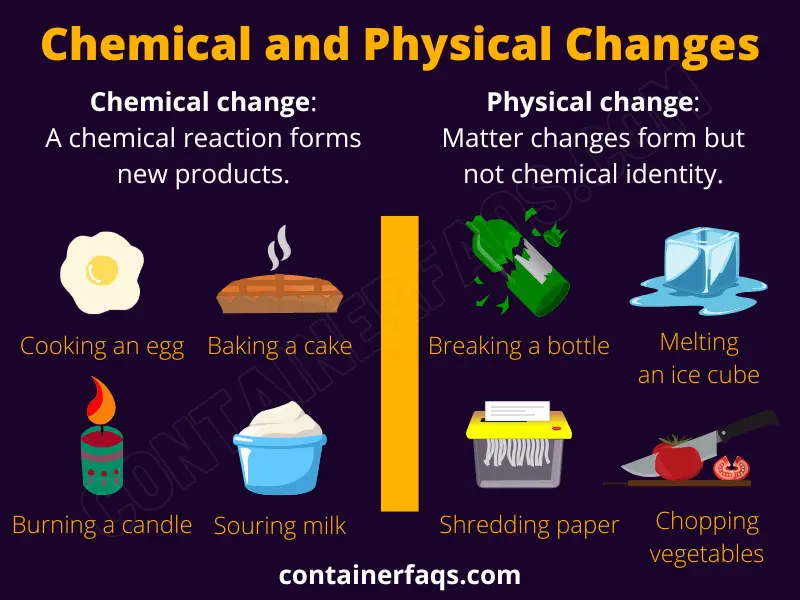The Mystery of Glass Breaking, Solved For Students: Is It a Physical Change?
Glass has always retained a few unique properties compared to other materials. The fact that it is easily moldable, opaque, and cheap to produce has led it to become one of the most popular materials used for multiple cases. Many wonder, is glass breaking a physical change?
Yes, glass breaking is a physical change as there is no change in the chemical composition of glass when it is broken. Moreover, broken glass can be melted and reconstructed back to its original form which indicates it is a reversible process.
However, to truly understand why glass breaking is a physical change, one must know the differences between both changes and why glass befalls in one category and not the other. And I will be talking about just that in this article.
Why Is Glass Breaking a Physical Change?
A physical change is one wherein the physical composition of a material is changed but it chemically remains the same. For example, water turning into steam or ice is a physical change as the molecules that make up water remain the same.
On the other hand, burning a piece of paper, for instance, leads to a chemical reaction which in turn, produces black ash that cannot be converted back into paper.
When glass breaks, it shatters into smaller shards and pieces. However, there is no chemical change between the instance where the glass was whole compared to the now bits and pieces.
Moreover, in terms of the space it occupies, we still can theoretically pick up every shard of glass, melt it down and then create a new piece of glass with exactly the same weight and shape.
When we’re able to enact change on material and reverse it, even on a theoretical level, it remains a physical change. However, yes, practically speaking; breaking glass is considered an irreversible process.
Is Glass Breaking A Reversible Process?
Yes, glass breaking is a reversible process. While recyclers tend to not accept broken glass and dispose of it instead, the reason why is not because of the fact that it isn’t impossible, but simply because it takes a lot of time and resources.
Plus, shards of glass can be harmful to handlers as they’re quite minute and are hard to pick apart. However, when molten, under specific circumstances, glass can be brought back to its original shape and form without any chemical reaction. Since the change inherently was inherently physical, bringing glass back also requires a physical reaction, and not a chemical one.
Using some particular compounds can help aid speed the process or refine it, glass can still be remade without it. So, contrary to popular belief, glass breaking does not contradict the notion that physical changes are not reversible.
Rather, it is a testament to the fact that while some procedures are scientifically possible, utilizing them in the practical world, in this case, reusing glass, is relatively ineffective. This is because it requires a staggering amount of resources, a lesser amount of which can be used to create new glass from scratch.
Ultimately, many may be left with the notion that glass breaking is an irreversible change and therefore falls under the umbrella of chemical changes. This is untrue as changing glass back to its original form is a simple process of melting the glass and molding it back to its original structure.
Why Is Glass Breaking Not a Chemical Change?
Glass breaking is not a chemical change because no new compounds or molecules have been created throughout the entire process. While yes, shards may seem like they are different in comparison to a glass jar, they share the same chemical properties.

For instance, they share the following characteristics:
● Density
● Melting point
● Chemical reactions
● Surface texture
● Chemical compositions
If a material, through whatever change, shares the above-mentioned traits but appears physically different, then, it can only be considered as a physical change.
Signs That a Chemical Change Has Taken Place
To further bring our point home, I’m going to be highlighting a few phenomenons that occur when a chemical change takes place:
● Formation of a gas
● Color change
● Formation of a precipitate
● Odor change
● Chemical change
From these events mentioned above, glass breaking does not lead to any of them. This further signifies that glass breaking is indeed a physical change and is not chemical in nature.
Can Glass Go Through a Chemical Change?
Yes, glass can go through chemical changes. The creation of glass itself (when added with certain compounds) leads it to undergo a chemical change. The most common chemical change in glass is seen when it’s dyed a particular color or when it is further strengthened or combined to create materials like fiberglass.
Unique properties of glass and the fact that it is relatively inexpensive have led it to be one of the most commonly used materials in the world.
Why Does Glass Break?
The process used to create glass places stress on the material right from the get-go. The overall structure of glass leads it to have some inherent fragility. Moreover, frequent temperature changes induce stress at various points on the surface of the glass.
Commonly, glass is shaped in quite uneven proportions, which leadsto further stress placed on particular points. When under this stress, any crack, no matter how small, can cause a ridge of tension that perpetuates into a line, leading to other cracks.
In essence, glass can crack due to no stress being put on that particular point simply because of other regions experiencing change. So, the entropy in relation to the rest of the glass is directly proportional to the point that requires the least amount of energy to shatter.
However, you still need to place a significant amount of stress on that one particular point to shatter the glass. In the grand scheme of things, that force might not be that high. But, on a local level, the particular pressure exerted on that point will be relatively high.
Compared to metal, glass is extremely brittle and has little to no elasticity. So, it can’t absorb pressure compared to a metal which, when extended after its point of elasticity, can still absorb more pressure but plastically (not being able to go back to its original shape.)
Because of its brittle nature and the inherent pressure present within it, glass’s lack of elasticity leads it to break very easily given a sufficient amount of local external force is applied to it.
Is Breaking Glass Easy?
Yes, compared to most other materials, breaking glass is easy. This is because the material does not require you to place pressure on its entire surface. Instead, high sums of localized pressure on a particular point will lead to tension ridges forming.
Once sufficiently pressured, these ridges will transform into cracks which will subsequently cause other points in the glass to start being overwhelmed by the added pressure leading to shatters that can then be further pressured for the entire structure to eventually crack and break.
The fact that breaking glass is easy is further testament to it being a physical change. This is because physical changes generally require much lesser activation energy compared to chemical changes. Since you aren’t changing or manipulating the chemical bonds present within the glass and are rather changing its physical shape; less energy is needed.
As a general rule of thumb, if a change requires an obscenely high amount of energy, for instance, burning an entire lump of wood – it is a chemical change.
What Is a Chemical and Physical Change?
A chemical change is one where a chemical reaction is produced and new products are created. On the other hand, a physical change may lead to matter changing its form, but it chemically remains the same.
For an easier explanation, turning water into ice still leaves a way for it to be converted back. Moreover, the fundamental chemical properties of ice and water remain the same. So, except for the physical structure of the molecules, nothing else changes.
On the other hand, with a chemical change, there is a fundamental difference in the chemical composition of the molecule. For instance, when blowing up a firework, a chemical process (combustion) converts the gunpowder mixed with other chemicals to what we see in the sky.

Once the reaction occurs, there is no way for us to bring the firework back to its original form. In essence, an irreversible change is chemical in nature while a reversible one indicates physical change.
To better understand the differences, I’ve concocted a quick table that describes all the differences between physical and chemical changes.
Difference between Physical and Chemical Changes
Both physical and chemical changes have a few differences that make it quite easy to identify whether a reaction belongs to the former or the latter. While bifurcating these changes for a particular element like glass may be difficult in some instances, it does help derive a clear picture.

| Physical Changes | Chemical Changes |
|---|---|
| When a material goes through a physical change, its composition remains similar despite its molecular rearrangement. | When a material undergoes a chemical change, its molecular composition is changed completely. Hence, chemical changes involve the formation of a new substance. |
| A good example is the fact that water as solid ice is H2O and as liquid and gaseous (steam) wate. Other examples include melting of water, boiling of water, ball-milling, grinding, etc. | As an example, when we burn a magnesium ribbon, it changes into magnesium oxide. Other examples include the burning of coal, rusting, digestion of food, formation of milk into curd, etc. |
| Physical change is a temporary change which means when the ice gets melted, it can be again solidified into ice. | Chemical changes are permanent changes. Rusting defines it all, which means when the iron gets rusted, it cannot be restored into iron simply. |
| Affect properties such as shape, size, density, etc. | Affects both physical and chemical properties, for example, rusting affects the colors’ texture, chemical formula, etc. |
| When it comes to absorption of energy, physical changes involve very less to no absorption of energy, compared to chemical changes. | The absorption and evolution of energy produced by chemical reactions like nuclear fission reactions are much bigger than a physical change. |
| Physical changes can also be caused by applying mechanical forces like burnishing, crushing, etc. | As compared with physical changes, it’s demanding to create chemical changes during mechanical forces. |
| Physical changes are reversible, and we obtain the same results in most cases. | Chemical changes are not reversible, and there is a slight chance of transformation into the original state. |
| Physical changes do not involve the creation of energy. | Chemical change can create energy in the shape of light, heat, sound, etc. |
| There is no new formation of substances in a physical change. Like, if we consider ball milling, it’s a process to produce the powder. That means the material will be the same, just in powder form. | Chemical changes can lead to the formation of new substances. If we take an example of photosynthesis, plants utilize carbon dioxide, water, and sunlight to produce sugar molecules. |
| Changing the texture or shape of materials, making powder of substances, and separating compounds by purification are a few applications of physical changes. | Causation of energy like biogas plants, and chemical reactions for the combinations of novel chemical molecules with specific properties are a few applications of chemical changes. |
Conclusion
Some figments of material physics remain quite a confusing matter, especially when it comes to exceptional cases such as the classification of glass breaking into a physical or chemical change.
With that being said, the fundamentals I’ve laid down above should pave a clear path towards understanding why exactly glass breaking is considered a physical change. Hopefully, it helped you learn something new today!
Sources
- Study.com: Why is breaking glass a physical change?
- Manocha Academy: Physical and Chemical Changes







